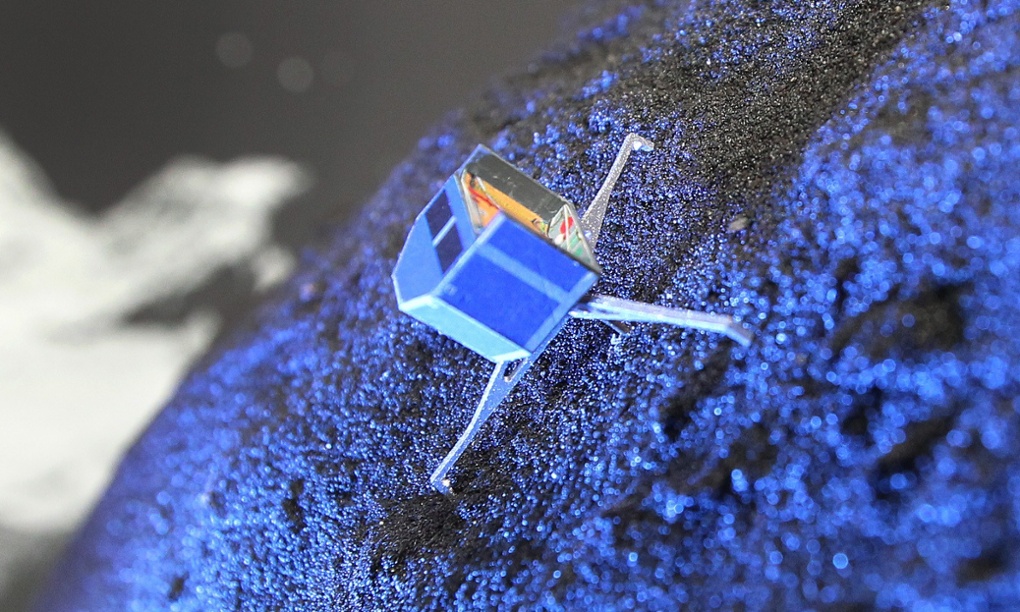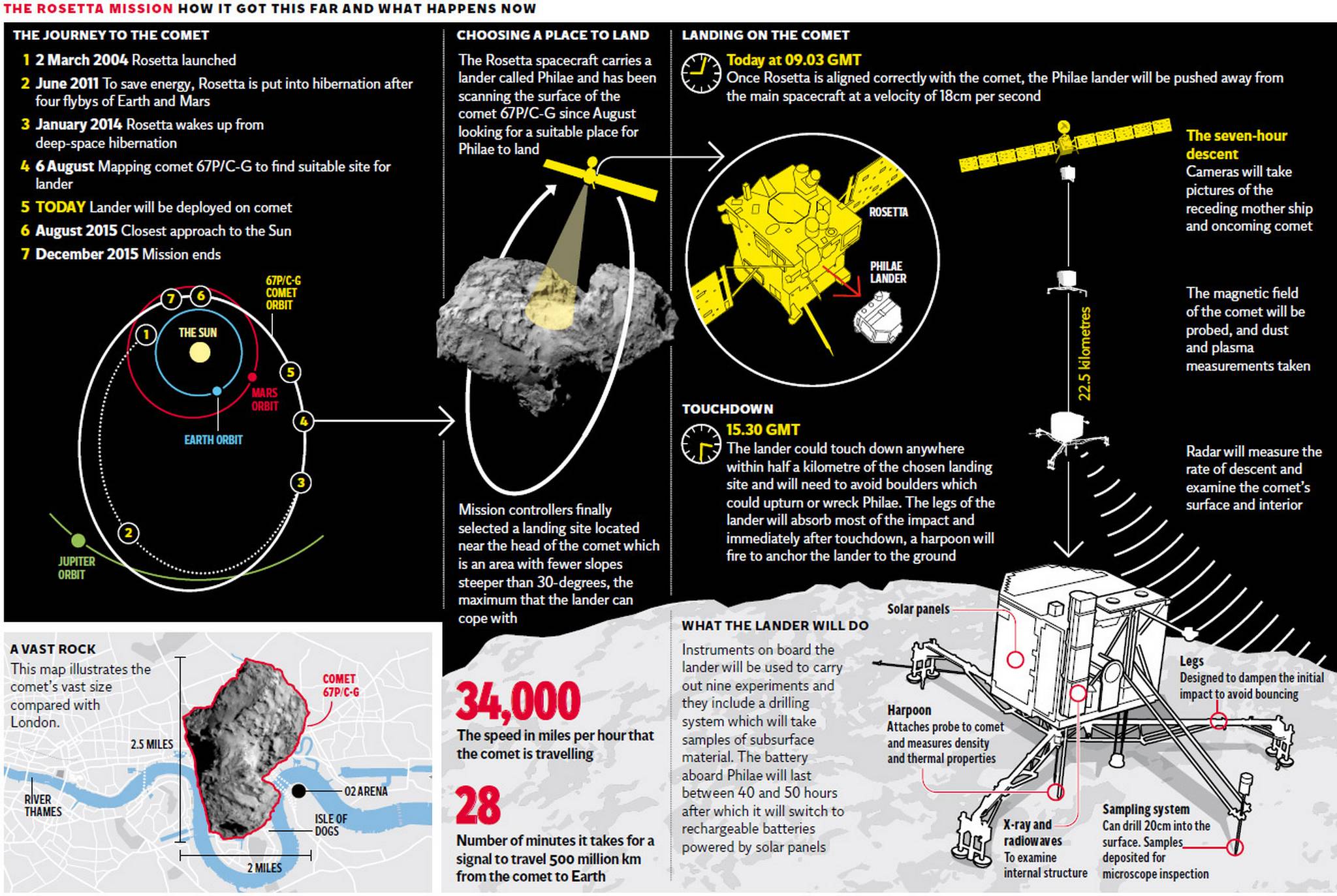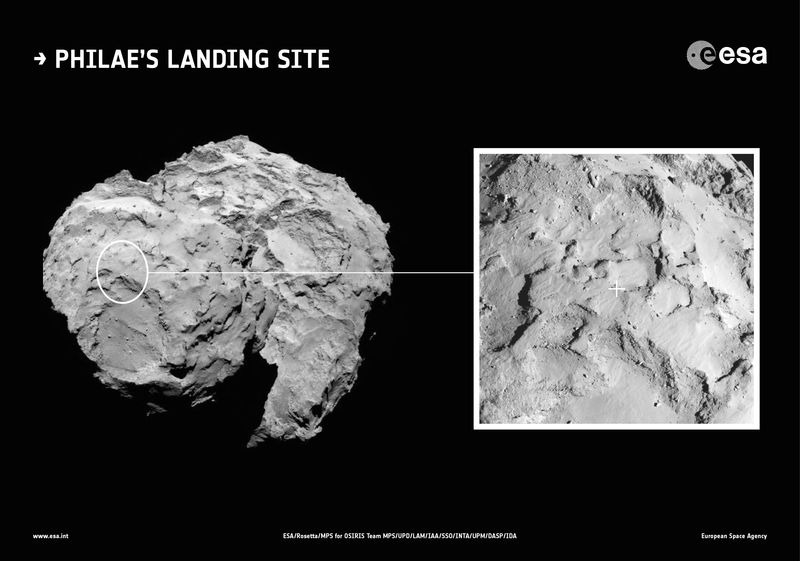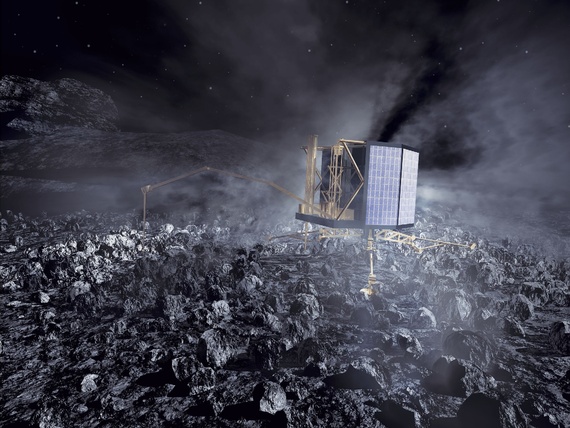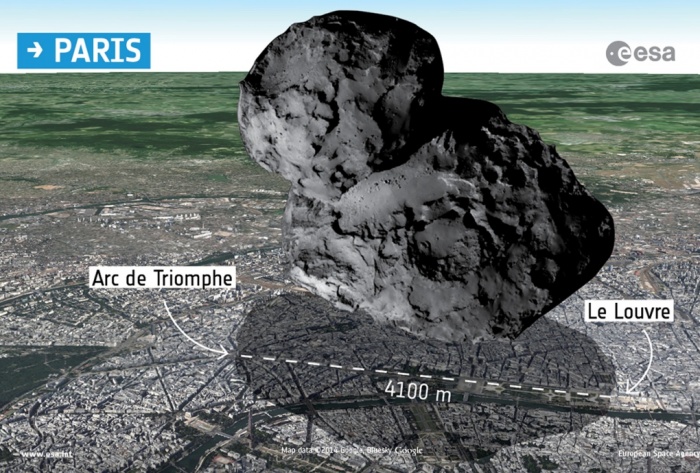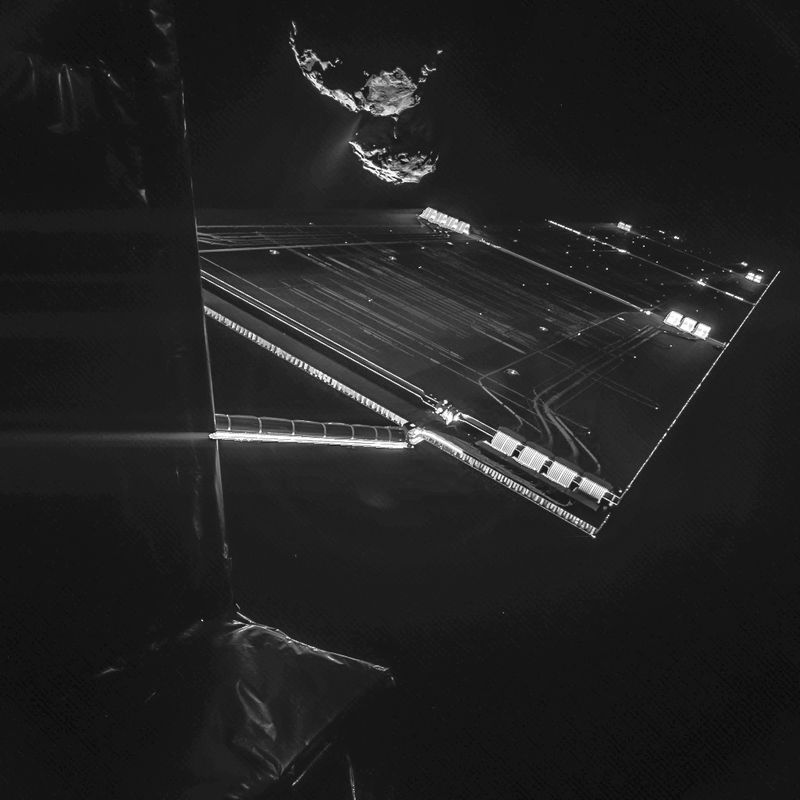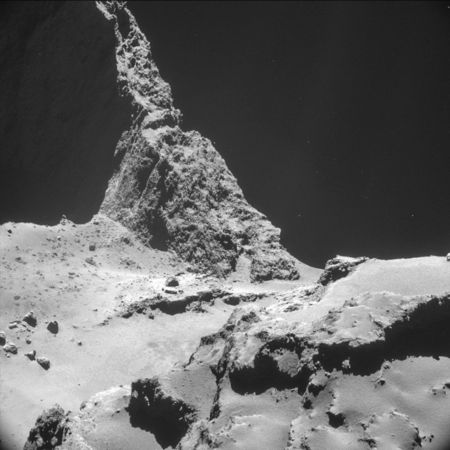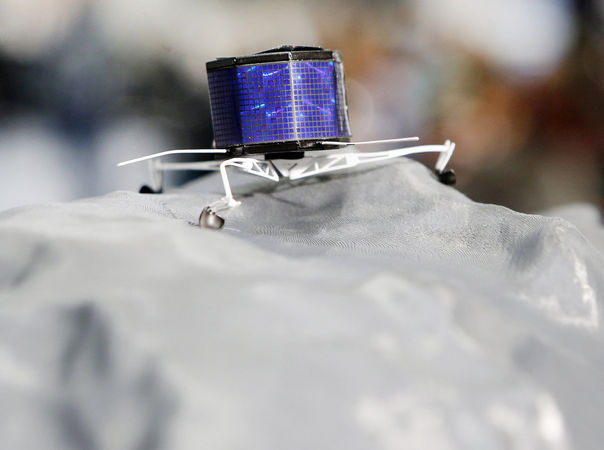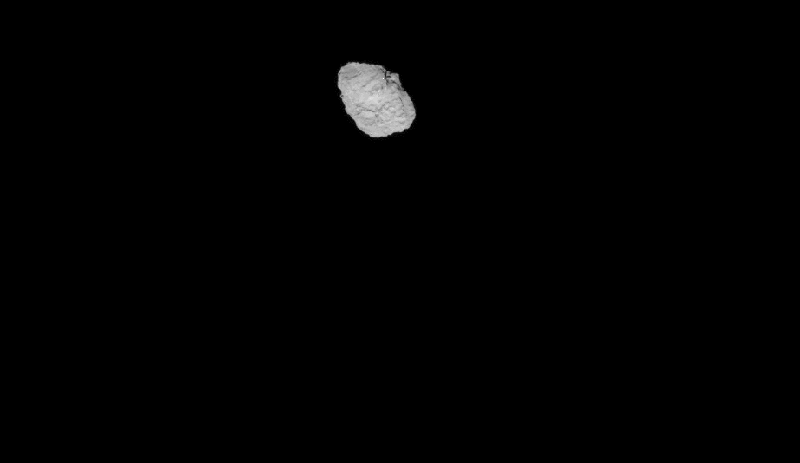For The First Time, We Have Landed Something On A Comet. Here's Why It Matters
Humankind has achieved a first — landing a washing machine-sized spacecraft on a comet speeding through our solar system at 41,000 mph. Here are answers to questions about the space mission and why it matters.
Late last night, on 12 November 2014 — after 10 years, 8 months and 11 days and covering 6.4 billion km journey — a small probe named Philae made history by becoming the first spacecraft to ever land on a comet. That's right, ON A HOLY FREAKING COMET!
Humankind made history this morning when the Rosetta mission made the first-ever landing on a comet. Just a couple minutes after 8:00 a.m. PST/11:00 a.m. EST, the European Space Agency received confirmation that after a roughly 7-hour descent, the mission’s lander craft, named Philae, touched down on the surface of comet 67P/Churyumov-Gerasimenko. “This is a big step for civilization,” said Jean-Jacques Dordain, the director general of ESA.
The Philae is a lander weighing 100 kg and was carried to the comet by a larger probe named Rosetta, launched and operated by the European Space Agency. In August 2014, Rosetta became the first spacecraft to ever be put into orbit around a comet.
Is this really the first spacecraft ever to land on the surface of a comet? Have we done something like this before?
No! This is a first. Other spacecraft have made contact with comets before, but only as crash-landings. (Take, for example, the aptly named Deep Impact probe, which made impact with a comet in 2005.) This is humanity's first attempt to soft-land on a comet—and actually landing means that Philae, if all goes according to plan, will be able to analyze the comet with the help of its scientific instruments.
Very simply, this is the first spacecraft ever to land on the surface of a speeding comet - a huge landmark in the history of space exploration. Because comets are remnants from the formation of the solar system it is hoped that it will unlock further clues about the development of life on Earth.
How difficult was it to land on a comet?
Nothing like Wednesday's landing had ever been attempted before. NASA landed a probe on an asteroid in 2001, but comets are much more volatile destinations because they continually release dust and gas that can harm a spacecraft. Also, because this landing was taking place 311 million miles from the Earth, the Rosetta spacecraft and the Philae lander it carried were both designed to perform the landing autonomously. Once they received the go-ahead, there was nothing scientists at mission control in Darmstadt, Germany, could do to adjust the lander's course.
oregonlive.comPhilae's separation from Rosetta also had to be extremely precise. An error of just 1 inch during separation could have put the lander more than 800 feet off target on the comet named 67P/Churyumov-Gerasimenko. But Paolo Ferri, head of mission operations for the space agency, said Philae's landing was almost perfectly on target — save for one unplanned bounce.
washingtonpost.comWere there any problems with the landing?
An image taken by Philae as it parted from its mothership, shortly after separation.
Image via guim.co.ukThere were several. First, the lander failed to wake up properly Tuesday. Scientists fixed that with a trick familiar to anyone who has used a computer. They rebooted it. After the separation from Rosetta, it became clear that there was a problem with Philae's downward thrusters. They were designed to press the lander onto the surface during the final touchdown, to help it get a grip using harpoons and screws.
oregonlive.comThe thruster failure wouldn't have been so dramatic if the harpoons had fired, but they didn't. So Philae bounced, once, before coming to rest again on the comet. Scientists are also trying to resolve intermittent communication problems with the lander, but those shouldn't interfere too badly with the mission.
washingtonpost.comBut why land on a comet?
The short answer: for science. The comet is thought to hold material dating from the origin of the solar system, some 4.5 billion years ago.
How will the lander collect data?
"The science starts the minute we get down to the ground," said Mark McCaughrean, a senior scientific adviser on the mission. Philae has 10 instruments on board — including devices to measure light, electrical magnetism and heat — and flying up above the comet the Rosetta spacecraft has another 11 instruments. The Philae lander will provide plenty of images of a world no human has ever seen close up and will drill below the surface to extract a sample of the comet that will be analyzed onboard.
oregonlive.comThe lander's batteries are expected to last just 64 hours — but that should be enough for scientists to gather a huge wealth of data. In addition, the lander has a solar panel that should provide an hour's worth of battery life per day for up to five months.
washingtonpost.comSo what data are scientists seeking?
Scientists have likened the trillion or so comets in our solar system to time capsules that remain virtually unchanged since the earliest moments of the universe. One of the things they are most excited about is the possibility that the mission might help confirm that comets brought the building blocks of life — organic matter and water — to Earth.
washingtonpost.comThey already know that comets contain amino acids, a key component of cells. Finding the right kind of amino acids and water would be an important hint that life on Earth did come from space.
oregonlive.comAnd what will it tell us about comets and our planet?
Rosetta will tell us if a bombardment from comets billions of years ago created the Earth’s oceans and the building blocks of all living things. Comets are the icy remnants of the phase of planet building in our solar system, some 4.5bn years ago. From these measurements we know that a large proportion of a comet is made of water-ice. This turns to vapour when heated by the sun, producing microscopic dust particles.
As the comet approaches the Sun it will heat up and some of this dust could be ablated to reveal more of the comet’s geology to scientists back here on Earth. These measurements will help scientists answer the question of whether a bombardment from comets billions of years ago brought water and simple organic molecules to Earth, paving the way for life.
How long will Philae be doing its thing on the comet?
A photo taken by a camera aboard Philae of Rosetta, with the comet in the background
Image via vox-cdn.comThe lander has solar panels that will recharge its battery until March—at which point the surface of the comet will become too hot for Philae to survive. "There is a fairly natural end to the mission," Rosetta's project manager has said.
Are there any challenges that lie ahead? What are they?
The comet is on a 6½-year elliptical orbit around the sun. At the moment it is getting closer to our star. This makes for great science, since Philae and Rosetta will be able to observe the comet becoming more active.
oregonlive.comThe picture taken with the navigation camera on Rosetta and released by the European Space Agency ESA shows the boulder-strewn neck region of Comet 67P/ChuryumovnGerasimenko, with the smaller lobe on the left and the larger lobe on the right. It was captured from a distance of 9.7 km from the center of the comet (about 7.7 km / 4.8 miles) from the surface) on Oct. 28, 2014
Image via oregonlive.comAs 67P approaches the sun, the amount of matter it sheds will greatly increase, posing a potential risk to the lander and even to the Rosetta spacecraft flying in tandem with the comet. As the comet reaches perihelion, the closest point to the sun, the rising temperatures could also damage Philae. But the lander should remain stuck to the comet forever, even after its systems have shut down.
washingtonpost.comRosetta will continue to fly alongside the comet until the end of its useful lifetime in about two years. Scientists have suggested that a fitting end would be for it, too, to land on the comet and reunite with the lander once more.
oregonlive.comWhy scientists wanted to put a lander on a comet?
A model of Rosetta lander Philae stands on a model of comet 67P/Churyumov-Gerasimenko, at the European Space Agency ESA in Darmstadt, Germany, Wednesday, Nov.12, 2014
Image via oregonlive.comThe first attempted landing on the surface of a comet is a huge landmark in the history of space exploration that will not only uncover further details about comets but could unlock further clues about the origins of our solar system and the development of life on Earth.
Comets are the icy remnants of the phase of planet building in our solar system, some 4.5 billion years ago. Thousands of them have been seen orbiting our sun and hundreds have been studied by Earth-based astronomers. From these measurements we know that a large proportion of a comet is made of water-ice. This turns to vapour when heated by the sun, producing a transient atmosphere around the comet together with microscopic “dust” particles, eventually flowing into the the tails for which they are so well known.
All this data will be especially interesting because the comet is believed to have formed 4.6 billion years ago, from material leftover as Earth and the solar system's other planets were coalescing. As a result, understanding the composition of comets could help us better model the formation of the solar system.
 vox.com
vox.com
Moreover, many scientists believe that in the period afterward, when the solar system was still a chaotic, collision-filled system, comets and asteroids were responsible for bringing water and perhaps even organic molecules to Earth. If water ice is present on this comet, as scientists hope, Philae will calculate the ratio of different sorts of hydrogen isotopes present in it — information that could provide an important clue as to whether the hypothesis is correct.
 vox.com
vox.com
